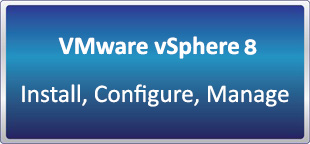دوره آنلاین مجازی سازی (VMware vSphere 8 (ICM

خلاصه دوره
دوره VMware vSphere ICM 8 به جهت آشنایی مدیران و مهندسین شبکه با تکنولوژی مجازی سازی سرورها توسط VMware vSphere 8طراحی شده است. در این دوره دانشجویان با نصب و راه اندازی سرویس دهنده های VMware ESXi و VMware vCenter و به صورت عملی آشنا خواهند شد .
مدت دوره:
40 ساعت
پيش نياز:
دارا بودن تجربه عملی در زمینه مدیریت یک سیستم عامل Server ، آشنایی با مدیریت بستر شبکه و یا گذراندن دوره های زیر :
- CCNA
- MCSA
اهداف دوره:
آشنایی و تسلط بر موارد زیر:
- راه اندازی و تنظیم سرویس دهنده های ESXi 7.x و vCenter 7.x
- راه اندازی و تنظیم بستر vNetworking و vStorage بر روی VMware ESXi 7
- نصب، راه اندازی و مدیریت ماشین های مجازی
- نصب، راه اندازی و مدیریت سرویس های VMware vMotion ، VMware HA ، VMware DRS و VMware FT جهت ایجاد High Availability
- استفاده از vCenter Converter جهت تبدیل سرویس دهندهای فیزیکی به ماشین های مجازی (P2V Conversion)
- نصب و راه اندازی (VMware Data Recovery (VDR جهت Backup و Restore کردن ماشین های مجازی
- استفاده از vCenter جهت مدیریت منابع ماشین های مجازی
- مدیریت دسترسی کاربران سیستم به بستر VMware vSphere 7
گوشه ای از دوره VMWare ICM در سماتک - استاد سینا غیبی
سرفصل دوره:
1. Course Introduction
• Introductions and course logistics
• Course objectives
2. vSphere and Virtualization Overview
• Explain basic virtualization concepts
• Describe how vSphere fits in the software-defined data center and the cloud infrastructure
• Recognize the user interfaces for accessing vSphere
• Explain how vSphere interacts with CPUs, memory, networks, storage, and GPUs
3. Installing and Configuring ESXi
• Install an ESXi host
• Recognize ESXi user account best practices
• Configure the ESXi host settings using the DCUI and VMware Host Client
4. Deploying and Configuring vCenter
• Recognize ESXi hosts communication with vCenter
• Deploy vCenter Server Appliance
• Configure vCenter settings
• Use the vSphere Client to add and manage license keys
• Create and organize vCenter inventory objects
• Recognize the rules for applying vCenter permissions
• View vCenter logs and events
5. Configuring vSphere Networking
• Configure and view standard switch configurations
• Configure and view distributed switch configurations
• Recognize the difference between standard switches and distributed switches
• Explain how to set networking policies on standard and distributed switches
6. Configuring vSphere Storage
• Recognize vSphere storage technologies
• Identify types of vSphere datastores
• Describe Fibre Channel components and addressing
• Describe iSCSI components and addressing
• Configure iSCSI storage on ESXi
• Create and manage VMFS datastores
• Configure and manage NFS datastores
7. Deploying Virtual Machines
• Create and provision VMs
• Explain the importance of VMware Tools
• Identify the files that make up a VM
• Recognize the components of a VM
• Navigate the vSphere Client and examine VM settings and options
• Modify VMs by dynamically increasing resources
• Create VM templates and deploy VMs from them
• Clone VMs
• Create customization specifications for guest operating systems
• Create local, published, and subscribed content libraries
• Deploy VMs from content libraries
• Manage multiple versions of VM templates in content libraries
8. Managing Virtual Machines
• Recognize the types of VM migrations that you can perform within a vCenter instance and across vCenter instances
• Migrate VMs using vSphere vMotion
• Describe the role of Enhanced vMotion Compatibility in migrations
• Migrate VMs using vSphere Storage vMotion
• Take a snapshot of a VM
• Manage, consolidate, and delete snapshots
• Describe CPU and memory concepts in relation to a virtualized environment
• Describe how VMs compete for resources
• Define CPU and memory shares, reservations, and limits
9. Deploying and Configuring vSphere Clusters
• Create a vSphere cluster enabled for vSphere DRS and vSphere HA
• View information about a vSphere cluster
• Explain how vSphere DRS determines VM placement on hosts in the cluster
• Recognize use cases for vSphere DRS settings
• Monitor a vSphere DRS cluster
• Describe how vSphere HA responds to various types of failures
• Identify options for configuring network redundancy in a vSphere HA cluster
• Recognize vSphere HA design considerations
• Recognize the use cases for various vSphere HA settings
• Configure a vSphere HA cluster
• Recognize when to use vSphere Fault Tolerance
10. Managing the vSphere Lifecycle
• Enable vSphere Lifecycle Manager in a vSphere cluster
• Describe features of the vCenter Update Planner
• Run vCenter upgrade prechecks and interoperability reports
• Recognize features of VMware vSphere® Lifecycle ManagerTM
• Distinguish between managing hosts using baselines and managing hosts using images
• Describe how to update hosts using baselines
• Describe ESXi images
• Validate ESXi host compliance against a cluster image and update ESXi hosts
• Update ESXi hosts using vSphere Lifecycle Manager
• Describe vSphere Lifecycle Manager automatic recommendations
• Use vSphere Lifecycle Manager to upgrade VMware Tools and VM hardware
جزئیات سرفصل آموزشی دوره VMWare vSphere 8 Install, Configure, Manage را از طریق لینک زیر دریافت کنید:

